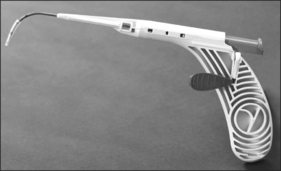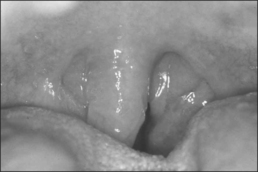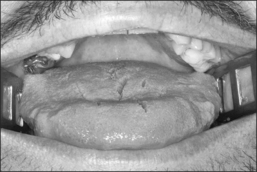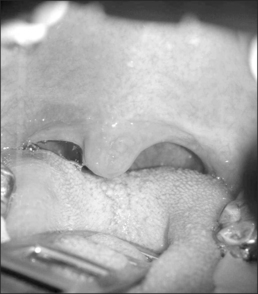Chapter 28 Palatal implants for primary snoring: short- and long-term results of a new minimally invasive surgical technique
1 INTRODUCTION
Snoring is a widespread symptom affecting about 50% of the adult population. Primary snoring without sleep disordered breathing is not harmful in itself. However, as snoring often causes social embarrassment and marital disharmony, affected patients apply to their physicians for treatment.
Therefore, both patients and physicians prefer a minimally invasive and less painful procedure as a primary option for the treatment of snoring. Since its invention in 1998 interstitial radiofrequency treatment of the soft palate has gained increasing interest among the public because it was the first minimally invasive surgical treatment bearing a low morbidity as well as a remarkable success rate.1 However, it is not a single-step procedure and treating the palate excessively may still impair the various functions of the soft palate in very few cases. Furthermore, a considerable relapse of snoring 1 to 1½ {} years after the last radiofrequency treatment has to be considered.2 Due to this relapse of snoring, alternative therapies with minimal morbidity and long-term efficacy are desired. Therefore, a new procedure was developed in 2001 where woven cylindrical implants are placed within the soft palate in order to stiffen the soft palate and thus reduce snoring. These implants are made of polyethylene terephtalate, a material which has been used in heart valve surgery for the last decades.
In this chapter, the patient selection criteria for the insertion of palatal implants in the treatment of snoring and its success rate as well as its morbidity are described according to the literature and to our own experience. The procedure is described in detail. It is performed identically in snorers as well as sleep apnea patients. During the last few years the delivery tool has been modified three times. It became smaller and contains more safety precautions against unwanted or incorrect implant deployment (Fig. 28.1).
2 PATIENT SELECTION
The Pillar® procedure consists of inserting implants into the junction of hard and soft palate in order to extend the hard palate, thus reducing the vibrating parts of the palate. The nature of the procedure where there is no resection or ablation of palatal tissue makes the patient selection criteria for this operation comprehensible. Patients with the following findings at the upper pharyngeal level should not receive palatal implants as a solitary intervention: nasal obstruction for whatever reason, distance between both tonsils less than 2 cm, excessive palatal and pharyngeal mucosa, and an uvula longer than 1 cm (Fig. 28.2). Patients with signs of tongue base snoring or obstruction in the clinical examination such as Friedman Tongue Position 3 or 4 (Fig. 28.3), tongue base hypertrophy, retrognathia, and floppy epiglottis are also not suitable candidates for this procedure. Obesity with a BMI above 32 kg/m² is known to impair any surgical intervention at the upper pharyngeal level and therefore is considered to be an exclusion criterion. In brief, patients without any obvious morphological anomaly in their nose and pharynx except a sufficiently long soft palate are suitable candidates for a solitary Pillar® procedure (Fig. 28.4). It has to be kept in mind that in all publications concerning the efficacy of palatal implants themselves, only those patients who fulfilled the above-mentioned inclusion criteria were treated.
The impact of nasal obstruction on snoring can be easily detected by applying a nasal decongestant and/or a nasal dilator before bedtime for a period of 7 days. If the improvement of nasal breathing during the night does not lead to a decrease of snoring, a combined versus a stepwise operation of the nose and the Pillar® procedure may be discussed with the patient. Of course, an adjunct conservative treatment with a mandibular advancement device, positional therapy, and/or weight reduction is possible at any time and vice versa. It is well documented in sleep apnea patients that palatal implants can be inserted synchronously to or as a second step after other soft palate procedures like UPPP.3 It is also possible in the case of a recurrence of symptoms after such operations.4 Future studies have to show whether this is also true for primary snorers. Radiofrequency of the soft palate, injection snoreplasty, and cautery-assisted palatal stiffening operations are not recommended as additional surgeries by us, because the tissue necrosis they induce is likely to increase the risk of implant extrusion and infection (see Complications below). There are no data concerning the combination with tongue base procedures (i.e. radiofrequency, laser resection of the lingual tonsil, genioglossus advancement, hyoid suspension), but obviously there is no surgical contraindication as different anatomical sites are addressed. However, tongue base procedures are rarely used in primary snoring anyway.
If palatal implants are used as additional surgery, one will lose the minimally invasive character of the intervention in most cases. Therefore, it has to be investigated whether the indication for an isolated Pillar® procedure may generally be extended to patients considered less suitable up to now, in order to offer this minimally invasive procedure as a real alternative to more aggressive operations as mentioned above. Furthermore, it is not yet clear whether additional methods for the assessment of the site of snoring sound generation can improve the selection process towards a better outcome. Regarding this issue, sound analysis using the SNAP®system did not increase the success rate.5 Multi-channel pressure recordings during natural sleep and videoendoscopy during wakefulness as well as under sedation are still under investigation.
The implant is a braided segment of polyester filaments intended for permanent implantation. The implant is 18mm in length and has an outer diameter of 1.5mm. The delivery tool (See Fig. 28.1) consists of a handle and 14-gauge needle, with the implant preloaded. The implant is deployed by pushing the thumb switch. Three implants are placed near the midline into the soft palate near the junction of hard and soft palate as if the hard palate was extended by the implants. The curved needle has three markings: a full insertion marking, a halfway depth marking, and a needle tip marking. Care must be taken to remove the transport lock and the plastic sleeve covering the tip of the needle, before attempting insertion of the implants. Each delivery tool contains one implant. The delivery tools are not reusable, and should be appropriately disposed of in a sharps container after the procedure.
The exact location of the insertion sites is determined by palpating the junction of the soft and hard palate and may be marked by the surgeon. The needle is inserted in the midline first while the neck is slightly extended, thus giving more space between chest and delivery tool and making it easier to follow the angle and curvature of the soft palate. The needle is then advanced towards the free margin of the soft palate to the full insertion marking which still has to remain visible. Care must be taken to always stay in the muscle layer (Fig. 28.5). Correct positioning of the needle can be checked either by palpation or, more easily, by making the soft palate move anteriorly and posteriorly with the needle.At this point the device is unlocked by pressing the lock located beneath the slider downwards. The slider is pushed halfway, until a click is heard. The needle is then withdrawn until the halfway depth marker, and the slider is pushed all the way in, thus deploying the implant into the channel which has been created in the soft palate by the needle. The position of the slider can be determined by looking at the windows on the side of the delivery tool. The needle is then withdrawn following the curvature of the needle, by moving the delivery tool in an arching fashion. If resistance is felt while delivering the implant, it usually means that the implant is pushing against the end of the previously created tunnel. Withdrawing the needle as the slider is pushed all the way in will usually result in adequate placement of the implant. The two lateral implants are inserted in the same fashion, as close as possible to the midline implant, about 2 mm apart (Fig. 28.6). A good way of estimating this distance is by using the diameter of the needle (approx. 2 mm).
< div class='tao-gold-member'>
Stay updated, free dental videos. Join our Telegram channel

VIDEdental - Online dental courses







